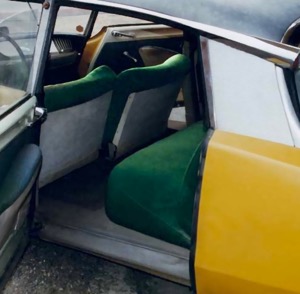by James Kraus

Citroën DS in Vert Printemps (Spring Green) with Champagne (Ivory) roof
Citroën dropped a bombshell when it unveiled the DS 19 at the Paris Salon in October of 1955. It was so futuristic in style that it appeared to have beamed-in from another planet. Even better, the car had the technical specification that fully justified the space-age exterior: self-leveling hydropneumatic suspension, adjustable ride-height, disc brakes, radial tires, powered steering, brakes, clutch and gearchange, aluminium and fibreglass body panels and active load-proportional braking. Never before or since has a new car been introduced with such an advanced specification and so many new technical innovations.
Apparently, Citroën wished to further advance the futuristic aura of the new DS via an advanced, fashion-forward colour palette.
This was quite a departure for Citroën, heretofore known for their sombre colours. When the DS made its debut, its predecessor, the Traction Avant, was only available in greys, blues and black, and the recently-introduced 2CV was offered solely in a single shade of grey.
While enticing and unusual colours were becoming all the rage in the 1950’s, no other manufacturer employed them quite like Citroën. Their embrace of colour went beyond a bold selection of pigments and fabrics, finding its fullest expression in the coordination and mixing of colour.
Most DS models were a symphony of three major colours, the body, the roof and the interior fabric. The fiberglass roof was initially available in four paint finishes: black, pale aqua, ivory and aubergine (eggplant.) Later, the aqua and ivory were superseded by silver-grey and white. The less-expensive ID came with a white translucent roof, with no alternative colour choices.

DS with Bleu Royal (Royal Blue) Jersey interior. Shown here with Gris Rosé (Pinkish Grey) body and Bleu Turquoise (Aqua) roof
The original 1956 models produced a hint of what was to come with a vibrant green exterior color, Vert Printemps, and an available electric blue interior (Bleu Royal.) In 1957, Citroën further pushed the boundary with the introduction of Capucine, a sort of seafood red, reminiscent of shrimp or lobster. These oceanic reds were quite popular in the 1950s, but disappeared as the 1960s arrived.
In the U.S., Ford briefly introduced a new variant, Samoan Coral, in 1964 as a limited one-year-only special-order color on Ford Galaxies and Thunderbirds. In the late-1960’s, it reappeared in Italy as Rosso Salmone to great effect on the Lancia Fulvia Sport Zagato.

ID in Capucine

ID in Capucine with translucent white fibreglass roof and Rust Jersey Cloth
In 1958, Jonquille (Daffodil), an intense Chartreuse-like yellow-green debuted.

DS in Jonquille with Silver-Grey roof and newly available Bronze Helanca interior fabric
Even more avant-garde, a new upholstery option was introduced, Helanca.

ID in Ecaille Blonde with Bronze Helanca (large pattern) Cloth interior. In Bronze, Helanca was redolent of leopard skin.
Ecaille Blonde (Pale Tortoiseshell) made an entrance on the 1959 models.

ID in Ecaille Blonde (Pale Tortoiseshell) with translucent white fibreglass roof and Rouille (Rust) Jersey Cloth interior
As a final flourish, in 1961 Ambre Doré (Golden Amber) and Absinthe were added to the color palette, which now encompassed 13 lower-body colours, five roof selections and seven interior choices.

Wild in the streets: A DS in Ambre Doré with (age-faded) Aubergine roof and Green Jersey Cloth interior

ID in Absinthe with translucent white fibreglass roof and Red Helanca (small pattern) Cloth interior
Here are two more intriguing amalgamations:

DS in Rouge Esterel (Esterel Red) with Blanc Carrare (Carrara White) roof and Green Jersey Cloth interior

ID in Black with white translucent fibreglass roof and Bleu Royal Jersey Cloth interior
The colour combinations at Citroën were unrivalled: green with red or blue; yellow with blue, green or eggplant; tortoiseshell with blue…
Alas, as the world took a step back from its unbridled embrace of futurism in the early 1960’s, so did Citroën colourists. By 1963, the more vivid and adventurous hues were all gone, and the bold pattern of the Helenca fabric was reduced in scale.
The early DS set a benchmark for sophisticated utilization of colour in automotive design. Particularly noteworthy was their novel use of eggplant as an alternative to black or brown as a dark neutral. Over a decade later, Charles and Ray Eames used eggplant in a similar manner as a frame-colour option on their Aluminum Group and Soft-Pad Group furniture for Herman Miller.
All photos courtesy of Le Nuancier DS
In regards to the “Seafood Reds” – these were very popular in the 1950’s and I always liked them. It is always refreshing to see a restored model in one of these colors. Volkswagen offered a Coral Red from 1956 to 1958 that was quite similar to the Citroen Capucine.